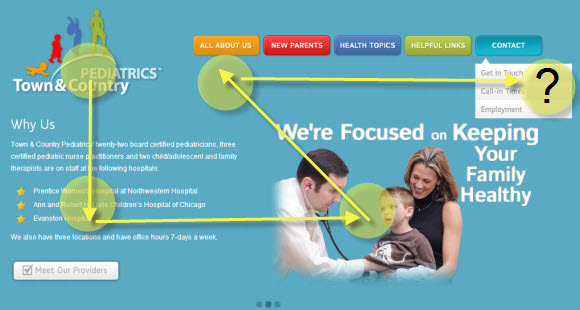You know a good website when you see it.
But what is it exactly that makes it so darn good?
Here are six things the best websites in the world do,
1. The best websites unify the experience
To create a strong brand experience visually, web design has to be part of the overall design strategy.
By unifying design practices across all contact points, a web design becomes part of a cohesive and distinctive user experience for its customers whether they are on the Internet, experiencing a product or visiting a brick-and-mortar location.
Lego does a good job unifying their design from web to retail to product,
Abercrombie and Fitch successfully translates their dark, slick, sexy mood from their stores to their online experience- complete with their signature images of shirtless guys.
2. The best websites emphasize content
Modern web design is all about facilitating and emphasizing the content.
Websites like Facebook and Pinterest are built around user content and their simple, clean and non-intrusive frameworks have surfaced as better design output than their clunky alternatives.
Browser compatibility, with new developments like CSS3 and HTML5, has made things interesting for web designers.
The best websites in the world take browser compatibility into account using one of two methods:
- Progressive enhancement – all users get a basic version of the website and, if they have a modern/powerful browser, sophisticated functionality is added to the user experience.
- Graceful degradation – the website will be built to cutting edge standards but provide a ‘degraded’ basic version to users using old browsers and computer systems.
At first, the difference between these two concepts may not be obvious. However, the difference in the design and development workflow is drastically affected by the method chosen.
In many cases, when choosing graceful degradation, outdated browsers are typically not considered until the project is virtually complete.
Progressive enhancement, on the other hand begins with the most basic component of the web experience — the content. From here, layers such as CSS and JavaScript are added to enhance the experience for those that can enjoy it.
3. The best websites deliver a custom user experience
The age of the ‘one-size-fits-all’ approach has long ended.
From simple things like personalized account settings that allow users to set favorite pages, change color schemes and control their information to complex systems that retain individual preferences and change dynamically in response to different customers, great design is about giving each user exactly what they want.
Amazon is a classic example of a website that delivers personalized web experiences to its customers (such as personal recommendations, wish lists and more).
But Amazon goes a step further with personalization. They launched ‘Amazon pages’ service which allows users to create custom company pages on Amazon.com, complete with personal URLs, big product images, updates feed, analytics and integration with social media.
But the best websites in the world know how to balance customization with accessibility. They don’t create sophisticated, technology-heavy solutions that only a segment of your users can use.
4. The best websites are flexible
Innumerable screen devices, browsers and operating systems out there, web and app design can no longer be created along rigid and static dimensions.
The effectiveness of web design is now judged on how well it adapts to the devices and platform its target customers will be viewing it on. Innovations like CSS 3, HTML 5 and Java etc. allow us to create web experiences that adapt to the technology and platform the end user is utilizing.
Services like TypeKit provide us with the freedom to use rich typography- and make sure everyone is able to access it.
Mashable called 2013 the ‘Year of Responsive Web Design’ and its own redesigned highly responsive website is a good representation of the future of web design.
5. The best websites streamline processes
In web design terms, we call this the ‘usability’.
The best websites consider the many different paths customers might take to achieve their goals on the website. By removing friction along these paths, users have a better experience and ultimately convert more often.
Let’s take a for instance:
A mother in Chicago is in trouble. She has a child with a high fever and her pediatrician is not open on Sunday.
She needs to find a pediatrician that can see her sick child.
Her path might look like this,
- She Googles the term ‘chicago pediatrician’
- Lands on the home page of Town and Country Pediatrics
- Scans the visual display,
- Looks at the logo
- Scans a few bullets on “Why Choose Us?”
- Looks at the hero image
- She likes what she sees. Now she wants to know if they are open on Sunday.
- She scans the navigation
- None of the navigation items are an obvious place to start
- She tries the “Contact” tab
- She doesn’t see hours
- She picks up her cell phone and calls the pediatrician to find out if they are open.
This isn’t ideal for the mother or the pediatrician’s office. The mother has a sick child and is trying to act fast. The pediatrician is paying someone to tell the distraught mother something that could be easily communicated through the website.
This is just one of several use cases for this website. This is just one of many “paths” that a visitor might take to solve a problem.
The best websites in the world anticipate what users need and provide an experience with no friction.
6. The best websites integrate social
The importance of social media in our digital present and future is undeniable.
To become truly social, websites and content have to be designed in a way that makes them fit for social consumption digitally.
Pepsi’s spanking new homepage is built around social media updates from its customers. The Pepsi homepage lives at the intersection of beautiful design and social sharing.
The Cleveland Clinic’s Health Hub drives social sharing and thought leadership for the Cleveland Clinic brand. Over 330,000 people get new content from Cleveland Clinic via Facebook.
Your turn. What do the best websites in the world do well in your opinion?























